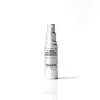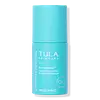What's inside
What's inside
 Key Ingredients
Key Ingredients

 Benefits
Benefits

 Concerns
Concerns

 Ingredients Side-by-side
Ingredients Side-by-side

Water
Skin ConditioningAscorbyl Palmitate
AntioxidantTriethanolamine
BufferingCyclopentasiloxane
EmollientCyclohexasiloxane
EmollientHexyl Laurate
EmollientGlyceryl Stearate
EmollientButylene Glycol
HumectantDimethyl Mea
BufferingPolysorbate 20
EmulsifyingGlycerin
HumectantCaprylic/Capric Triglyceride
MaskingDimethicone
EmollientSodium Hyaluronate
HumectantUrea
BufferingMangifera Indica Seed Butter
Skin ConditioningButyrospermum Parkii Butter
Skin ConditioningZinc Sulfate
AntimicrobialPyridoxine Hcl
Skin ConditioningLecithin
EmollientTocopheryl Linoleate/Oleate
AntioxidantSodium Metabisulfite
AntioxidantSodium Sulfite
PreservativeUbiquinone
AntioxidantParfum
MaskingBenzyl Salicylate
PerfumingGeraniol
PerfumingLinalool
PerfumingDiethanolamine
BufferingCitric Acid
BufferingDisodium EDTA
Phenoxyethanol
PreservativeMethylparaben
PreservativeButylparaben
MaskingEthylparaben
PreservativePropylparaben
PreservativeCI 77891
Cosmetic ColorantWater, Ascorbyl Palmitate, Triethanolamine, Cyclopentasiloxane, Cyclohexasiloxane, Hexyl Laurate, Glyceryl Stearate, Butylene Glycol, Dimethyl Mea, Polysorbate 20, Glycerin, Caprylic/Capric Triglyceride, Dimethicone, Sodium Hyaluronate, Urea, Mangifera Indica Seed Butter, Butyrospermum Parkii Butter, Zinc Sulfate, Pyridoxine Hcl, Lecithin, Tocopheryl Linoleate/Oleate, Sodium Metabisulfite, Sodium Sulfite, Ubiquinone, Parfum, Benzyl Salicylate, Geraniol, Linalool, Diethanolamine, Citric Acid, Disodium EDTA, Phenoxyethanol, Methylparaben, Butylparaben, Ethylparaben, Propylparaben, CI 77891
Water
Skin ConditioningPropanediol
SolventC15-19 Alkane
SolventGlycerin
Humectant1,2-Hexanediol
Skin ConditioningLactococcus Ferment Lysate
Skin ConditioningPentylene Glycol
Skin ConditioningCetyl Alcohol
EmollientChlorella Vulgaris Extract
Skin ConditioningVaccinium Macrocarpon Fruit Extract
AstringentTridecapeptide-1
Skin ConditioningCeramide AP
Skin ConditioningCeramide As
Skin ConditioningCeramide Ns
Skin ConditioningCeramide EOP
Skin ConditioningCeramide NP
Skin ConditioningSodium Hyaluronate
HumectantHydrolyzed Sodium Hyaluronate
Skin ConditioningSodium Acetylated Hyaluronate
HumectantSodium Hyaluronate Crosspolymer
HumectantAloe Barbadensis Leaf Juice
Skin ConditioningLactobacillus
Skin ConditioningCurcuma Longa Root Extract
MaskingLactobacillus Ferment
Skin ConditioningBeta Vulgaris Root Extract
Skin ConditioningRetinal
Skin ConditioningArginine
MaskingDiisostearyl Malate
EmollientAlpha-Glucan Oligosaccharide
CleansingBisabolol
MaskingInulin
Skin ConditioningArachidyl Alcohol
EmollientLactic Acid
BufferingSclerotium Gum
Emulsion StabilisingCitric Acid
BufferingBehenyl Alcohol
EmollientMalic Acid
BufferingPolymnia Sonchifolia Root Juice
Skin ConditioningArachidyl Glucoside
EmulsifyingHydrogenated Lecithin
EmulsifyingPolyacrylate Crosspolymer-6
Emulsion StabilisingCellulose Gum
Emulsion StabilisingGlucose
HumectantCalcium Chloride
AstringentFructose
HumectantCholesterol
EmollientSodium Phytate
2,3-Butanediol
HumectantCalcium Alginate
MaskingGlyceryl Stearate
EmollientLecithin
EmollientCellulose
AbsorbentSodium Hydroxide
BufferingEthylhexylglycerin
Skin ConditioningCaprylyl Glycol
EmollientMaltodextrin
AbsorbentXanthan Gum
EmulsifyingSodium Benzoate
MaskingButylene Glycol
HumectantSodium Chloride
MaskingPotassium Sorbate
PreservativeWater, Propanediol, C15-19 Alkane, Glycerin, 1,2-Hexanediol, Lactococcus Ferment Lysate, Pentylene Glycol, Cetyl Alcohol, Chlorella Vulgaris Extract, Vaccinium Macrocarpon Fruit Extract, Tridecapeptide-1, Ceramide AP, Ceramide As, Ceramide Ns, Ceramide EOP, Ceramide NP, Sodium Hyaluronate, Hydrolyzed Sodium Hyaluronate, Sodium Acetylated Hyaluronate, Sodium Hyaluronate Crosspolymer, Aloe Barbadensis Leaf Juice, Lactobacillus, Curcuma Longa Root Extract, Lactobacillus Ferment, Beta Vulgaris Root Extract, Retinal, Arginine, Diisostearyl Malate, Alpha-Glucan Oligosaccharide, Bisabolol, Inulin, Arachidyl Alcohol, Lactic Acid, Sclerotium Gum, Citric Acid, Behenyl Alcohol, Malic Acid, Polymnia Sonchifolia Root Juice, Arachidyl Glucoside, Hydrogenated Lecithin, Polyacrylate Crosspolymer-6, Cellulose Gum, Glucose, Calcium Chloride, Fructose, Cholesterol, Sodium Phytate, 2,3-Butanediol, Calcium Alginate, Glyceryl Stearate, Lecithin, Cellulose, Sodium Hydroxide, Ethylhexylglycerin, Caprylyl Glycol, Maltodextrin, Xanthan Gum, Sodium Benzoate, Butylene Glycol, Sodium Chloride, Potassium Sorbate
Ingredients Explained
These ingredients are found in both products.
Ingredients higher up in an ingredient list are typically present in a larger amount.
Butylene Glycol (or BG) is used within cosmetic products for a few different reasons:
Overall, Butylene Glycol is a safe and well-rounded ingredient that works well with other ingredients.
Though this ingredient works well with most skin types, some people with sensitive skin may experience a reaction such as allergic rashes, closed comedones, or itchiness.
Learn more about Butylene GlycolCitric Acid is an alpha hydroxy acid (AHA) naturally found in citrus fruits like oranges, lemons, and limes.
Like other AHAs, citric acid can exfoliate skin by breaking down the bonds that hold dead skin cells together. This helps reveal smoother and brighter skin underneath.
However, this exfoliating effect only happens at high concentrations (20%) which can be hard to find in cosmetic products.
Due to this, citric acid is usually included in small amounts as a pH adjuster. This helps keep products slightly more acidic and compatible with skin's natural pH.
In skincare formulas, citric acid can:
While it can provide some skin benefits, research shows lactic acid and glycolic acid are generally more effective and less irritating exfoliants.
Most citric acid used in skincare today is made by fermenting sugars (usually from molasses). This synthetic version is identical to the natural citrus form but easier to stabilize and use in formulations.
Read more about some other popular AHA's here:
Learn more about Citric AcidGlycerin is already naturally found in your skin. It helps moisturize and protect your skin.
A study from 2016 found glycerin to be more effective as a humectant than AHAs and hyaluronic acid.
As a humectant, it helps the skin stay hydrated by pulling moisture to your skin. The low molecular weight of glycerin allows it to pull moisture into the deeper layers of your skin.
Hydrated skin improves your skin barrier; Your skin barrier helps protect against irritants and bacteria.
Glycerin has also been found to have antimicrobial and antiviral properties. Due to these properties, glycerin is often used in wound and burn treatments.
In cosmetics, glycerin is usually derived from plants such as soybean or palm. However, it can also be sourced from animals, such as tallow or animal fat.
This ingredient is organic, colorless, odorless, and non-toxic.
Glycerin is the name for this ingredient in American English. British English uses Glycerol/Glycerine.
Learn more about GlycerinGlyceryl Stearate is a mix of glycerin and stearic acid.
It is used to stabilize the mixing of water and oil ingredients. By preventing these ingredients from separating, it can help elongate shelf life. It can also help thicken the product's texture.
As an emollient, it helps soften skin and supports barrier-replenishing ingredients.
In cosmetics, Glyceryl Stearate is often made from vegetable oils or synthetically produced.
This ingredient may not be fungal-acne safe
Fun fact: The human body also creates Glyceryl Stearate naturally.
Learn more about Glyceryl StearateLecithin is a term for a group of substances found in the cell membranes of plants, animals, and humans. They are made up of mixture of phospholipids.
This ingredient has emollient and emulsifying properties.
As an emollient, lecithen helps soften the skin and creates a barrier to keep moisture in.
As an emulsifier, it also helps prevent water and oil ingredients from separating. Lecithin can also help ingredients be better absorbed by the skin.
This is because the phospholipids in lecithin produce liposomes. Liposomes help other ingredients get through the skin barrier.
Depending on the source of this ingredient, lecithin may not be fungal acne safe. This is because some sources of lecithin come from soybean oil, which may feed the malassezia yeast that feeds fungal acne.
We recommend reaching out to the brand you are purchasing from to inquire about the source of their lecithin.
Some other names for this ingredient include soy lecithin and deoiled soy lecithin.
Learn more about LecithinSodium Hyaluronate is hyaluronic acid's salt form. It is commonly derived from the sodium salt of hyaluronic acid.
Like hyaluronic acid, it is great at holding water and acts as a humectant. This makes it a great skin hydrating ingredient.
Sodium Hyaluronate is naturally occurring in our bodies and is mostly found in eye fluid and joints.
These are some other common types of Hyaluronic Acid:
Learn more about Sodium HyaluronateWater. It's the most common cosmetic ingredient of all. You'll usually see it at the top of ingredient lists, meaning that it makes up the largest part of the product.
So why is it so popular? Water most often acts as a solvent - this means that it helps dissolve other ingredients into the formulation.
You'll also recognize water as that liquid we all need to stay alive. If you see this, drink a glass of water. Stay hydrated!
Learn more about Water